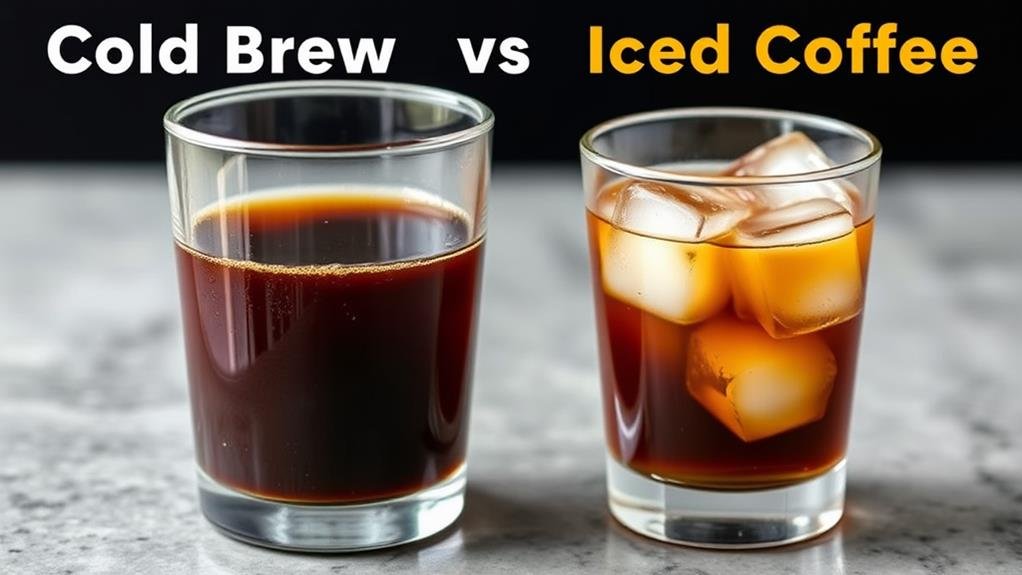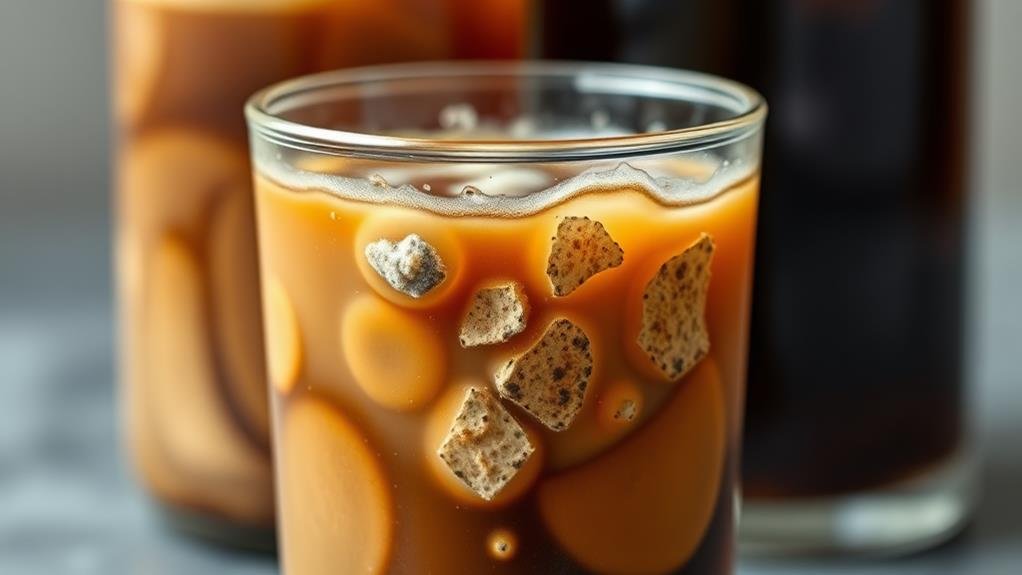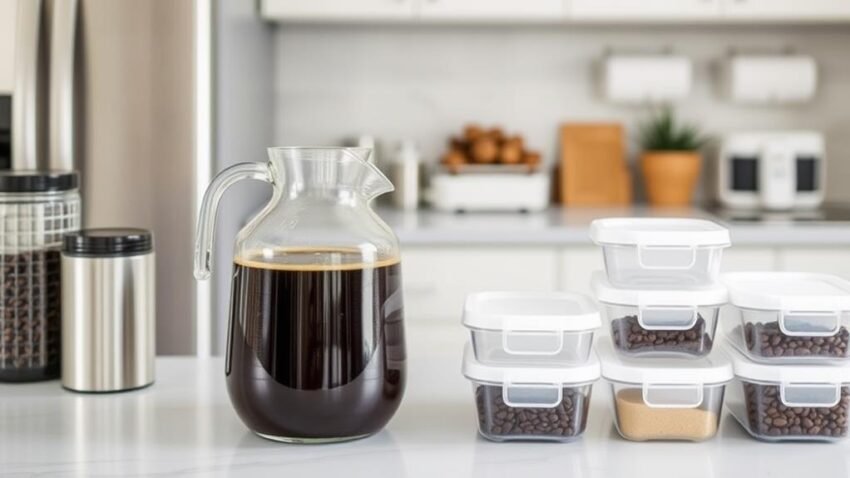I remember the first time I brewed a batch of cold brew coffee—it was like sipping a smooth, rich dream. But within a week, it had transformed into a bitter, unpleasant drink. This experience taught me that preserving cold brew's freshness is essential. If you're looking to enjoy your cold brew for longer, there are several key strategies to keep in mind. By using freshly ground coffee beans, storing the concentrate in airtight containers, and refrigerating it at the proper temperature, you can greatly extend its shelf life. Let's explore these tips further to make sure your next batch stays delicious for weeks to come.
Cold Brew Vs Iced Coffee

When it comes to coffee, few distinctions are as stark as those between cold brew and iced coffee. One of the most significant differences lies in their brewing processes. Cold brew involves steeping coffee grounds in cold water for 12-24 hours, which results in a smoother, less acidic beverage with a velvety texture and nutty undertones. On the other hand, iced coffee is typically brewed hot and then cooled down, leading to a more acidic taste with brighter flavors and bitterness.
Cold brew's lower acidity makes it gentler on the stomach compared to iced coffee. Additionally, cold brew contains lower levels of oils and fatty acids due to its less processed nature, making it a preferred choice for those seeking a robust caffeine kick. This difference also impacts their shelf life; cold brew has a longer shelf life due to its slow extraction process. This can be beneficial for coffee enthusiasts who prefer a drink that offers consistent taste and a extended shelf life compared to its hot-brewed counterpart.
Proper storage is essential for maintaining the unique flavor profile of cold brew. Unlike iced coffee, which can lose its flavor quickly, cold brew retains its taste when stored correctly. This distinctiveness in flavor and shelf life highlights why understanding the differences between these two types of coffee can enhance your overall coffee experience. By choosing cold brew, you're opting for a beverage with lower acidity and a longer shelf life, making it a more durable and enjoyable option over time.
Shelf Life in Refrigeration
To maximize the shelf life of cold brew coffee, proper refrigeration is essential. When stored in the refrigerator, cold brew can last for 7-10 days, with the best flavor experienced within the first week. The quality of the beans and the brewing method play significant roles in determining this shelf life. For instance, high-quality beans, like those sourced through meticulous sustainable sourcing practices, and a well-executed brewing process can extend the shelf life and maintain flavor.
Storage conditions are also pivotal. Keeping your cold brew in airtight containers helps preserve its flavor and extends its shelf life. If you're using a concentrate, it can stay fresh for up to two weeks when stored properly. Maintaining a temperature below 40F (4C) in your fridge is crucial to preserve the flavors of your cold brew.
Proper storage and refrigeration are essential to extend the shelf life of your cold brew coffee. By following these guidelines, you can enjoy your cold brew for a longer period without compromising on taste. Store-bought cold brews often have longer shelf lives due to airtight packaging or added nitrogen, but by adhering to these tips, you can achieve similar results at home. This way, you ensure that your cold brew stays fresh and delicious for as long as possible.
Signs of Spoilage

If you notice a strange smell emanating from your cold brew coffee, it's likely gone bad. This is one of the first and most obvious signs of spoilage. When cold brew is past its peak, it can develop an odor that's off-putting and distinct from the rich aroma you're accustomed to.
Another clear indicator of spoiled cold brew is unpleasant tastes. Bitterness or sourness that wasn't there before are red flags. Fresh cold brew should have a smooth, mellow flavor without any off-putting aftertaste. If your cold brew tastes notably different from how it did when it was fresh, it's probably spoiled.
Consuming spoiled cold brew can lead to stomach discomfort or nausea, which is why it's essential to identify these signs of spoilage early on. Extending the shelf life of your cold brew relies not only on good storage practices but also on recognizing when it's no longer safe to drink.
When in doubt, it's safer to discard suspected spoiled cold brew to avoid any potential health issues. Your health and the quality of your coffee are worth the extra caution when dealing with signs of spoilage.
Tips to Extend Shelf Life
Extending the shelf life of your cold brew coffee involves a few simple but effective strategies. To start, it's essential to store your cold brew in airtight containers. This helps slow down oxidation and maintain freshness.
Here are some key tips to keep in mind:
- Use Freshly Ground Coffee Beans: Grinding your coffee beans just before brewing ensures maximum flavor and a longer shelf life.
- Keep It Concentrated: Leave the coffee concentrated if you want to extend its shelf life. Diluting the entire batch can reduce its shelf life to just 2-3 days.
- Opt for Secure Lids: Containers with secure lids prevent nutrient loss and mold development, keeping your cold brew fresh.
- Maintain Stable Temperature: Store your cold brew in the refrigerator at a stable temperature below 40F (4C) to preserve the flavor.
Alternative Uses for Leftover Cold Brew

If you find yourself with leftover cold brew, don't worry about it going to waste. You can use it in creative recipes like smoothies, milkshakes, or coffee-flavored desserts. Additionally, it's perfect for infusing unique flavors into cocktails or even savory dishes.
Creative Recipes
When you have leftover cold brew, the possibilities are boundless. Instead of letting it go to waste, consider using it to create some innovative recipes that will enhance your culinary skills and satisfy your taste buds.
Here are a few ideas to get you started:
- Cold Brew Ice Cream and Popsicles: Use leftover cold brew to make delicious ice cream or popsicles. The rich, smooth flavor of cold brew pairs perfectly with creamy textures.
- Baking Recipes: Add cold brew to your baking repertoire by making cold brew brownies or cold brew tiramisu. These desserts gain a unique depth of flavor from the coffee.
- Cold Brew Cocktail or Mocktail: Transform leftover cold brew into a invigorating cocktail or mocktail. It's perfect for hot days and can be mixed with various ingredients to suit your taste.
- Smoothies and Shakes: Boost your smoothies and shakes with a splash of cold brew for an extra dose of caffeine and a rich coffee flavor.
These innovative uses not only help extend the shelf life of your cold brew but also open up a world of culinary possibilities. Whether you're baking, blending, or mixing drinks, leftover cold brew can be a versatile and delectable addition to many recipes.
Cocktail Infusions
After experimenting with creative recipes like cold brew ice cream and brownies, I found that leftover cold brew can also elevate your cocktail game. Cold brew cocktail infusions have become a popular trend in bars and restaurants, and for good reason. By incorporating leftover cold brew into your cocktails, you can add a unique coffee flavor that enhances the drinking experience. This technique not only reduces waste but also brings a creative twist to traditional drinks.
Cold brew adds depth and complexity to cocktails such as espresso martinis or coffee old fashioneds. Its rich flavor profile can transform these drinks into something truly special. For instance, substituting some of the liquor in an espresso martini with cold brew can give it a smoother, more coffee-forward taste. Similarly, adding cold brew to a coffee old fashioned can balance out the sweetness of the other ingredients.
Incorporating leftover cold brew into cocktail infusions is both practical and innovative. It's a great way to use up leftover coffee while creating unique beverages that are gaining popularity among cocktail enthusiasts. So next time you're mixing up a drink, consider giving cold brew a try; it might just become your new favorite ingredient.
Storage and Handling Best Practices
To prolong the shelf life of cold brew coffee, focusing on proper storage and handling is vital. This step plays a significant role in preserving the distinct flavor profile and freshness of your cold brew.
Here are some key practices to keep in mind:
- Store cold brew in airtight containers: This helps slow down oxidation, which can spoil the flavor.
- Keep it refrigerated: Store your cold brew at temperatures below 40F (4C) to maintain its flavors.
- Avoid diluting the entire batch: Diluting can introduce contaminants and impact the shelf life.
- Use high-quality coffee beans: Better beans generally lead to a longer shelf life and better taste.
Proper storage and handling are paramount for preventing mold development and ensuring that your cold brew coffee lasts longer. By following these simple tips, you can prolong the shelf life of your cold brew coffee and enjoy it for an extended period without compromising its quality. Remember, maintaining freshness is all about controlling environmental factors like temperature and exposure to air, so invest in airtight containers and keep them refrigerated. This way, you can savor that perfect cup of cold brew whenever you desire.
Conclusion
To sum it up, extending the shelf life of cold brew coffee is a delicate dance between fresh ingredients, secure storage, and consistent refrigeration. By following these steps, you can savor your cold brew for a longer period without compromising its flavor. Remember, a well-preserved cold brew is a fleeting treasure; cherish it wisely. With these tips, you'll be well on your way to enjoying every last drop of your concentrated coffee delight.

